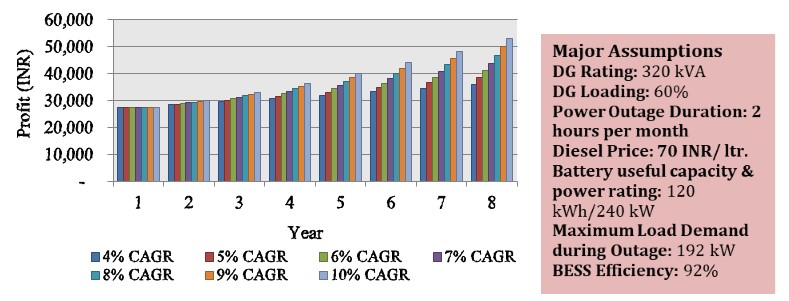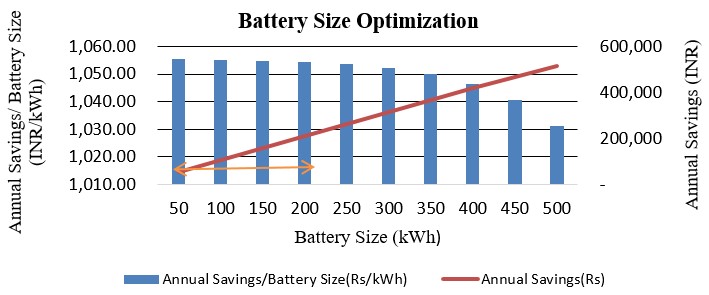Battery Energy Storage and Operational Use-Cases at the Electricity Distribution Network Level
Written by Ram Krishan and Er. Alekhya Datta
With increasing penetration of Distributed Energy Resources (DERs), in-particular solar PV and wind energy, and the intervention of smart monitoring & control devices, the modern electricity grid is undergoing a paradigm shift wherein effective and reliable operation of the electricity network has become imperative. Distribution utilities have a challenging task at-hand in terms of managing the peak-loading and ensuring reliable and high quality power supply alongside addressing the operational challenges posed by DERs including Electric Vehicle (EV) chargers. The situation becomes more pronounced in the case of metropolitan areas facing increasing load and space constraints and extreme weather variations such as those in New Delhi. Hence, the need for controllable balancing fleets at the distribution system level is being felt to maintain reliability and avoiding periodic distribution network augmentation. Battery Energy Storage System (BESS) is being considered to be one of the most prominent technological solutions to manage the electricity supply and demand gap in an efficient way, courtesy the rapid technological advancements and falling prices of Li-ion batteries in addition to their quick response feature. Several types of BESS technologies are being deployed at different levels within the electricity network for a variety of applications such as energy arbitrage, peak shaving, power back-up, power ramp control, frequency regulation, avoiding power scheduling mismatch penalties (known as ‘deviation settlement mechanism’ control in India) etc., based on their technological advantages and limitations. However, appropriate sizing and siting of BESS is imperative for any application so as to optimize the overall system operation. Few pilot demonstrations of BESS within the urban distribution network in the National Capital Territory (NCT) of Delhi are being undertaken under the US-India Collaborative for Smart Distribution System with Storage (UI-ASSIST) for three different applications (serving three distinct consumer categories) that have been identified after carrying out the pre-feasibility assessment. A preliminary study comprising of techno-economic analysis of different BESS technologies, load research, identification of plausible revenue streams and development of operational strategy was performed accordingly. The battery size and operational control scheme for these applications were determined to ensure system operation within the technical constraints of the selected battery technology which include the state of charge (SoC) operating window, battery degradation and charge/discharge rate limitations (either by technology or by regulations).
The pilot locations for BESS implementation were identified in consultation with the distribution utility based on the prefeasibility study that was carried out for each site. Consequently, three different applications of BESS were identified for the selected category of consumers, as listed in table 1. Further, the usable energy along with power requirement was evaluated for these applications, and accordingly these requirements were specified in a tender document (calling for installation bids) which also mentioned use of multiple battery technologies such as Lithium Ferro Phosphate (LFP), Nickel-Manganese Cobalt (NMC) and Advanced Lead Acid. However, LFP batteries emerged out to be the most suitable technology for the selected applications during tender evaluation process since they were found to be thermally more stable and cheaper than NMC batteries and having lesser environmental footprint than Advanced Lead acid batteries. The design capacity of the battery pack was calculated considering technical characteristics of the selected battery technology such as Depth of Discharge (DoD), round-trip efficiency and auxiliary consumption.
Table 1: BESS size and application for various consumer categories under the UI-ASSIST
| Pilot Locations | Usable Energy | Power Converter Rating | BESS Design Capacity | Battery Chemistry | Application | Benefit to utility/consumer |
| Category A (DT level) | 230 kWh | 140 kVA | 288 kWh (4*72kWh stack) | Li-ion (NMC/LFP**) or Adv. Lead Acid | Overload management of DT & energy arbitrage |
|
| Category B (Housing society) | 120 kWh | 270 kVA | 216 kWh (3*72 kWh stack) | Li-ion (NCM/ LFP**) | Back-up power & energy arbitrage |
|
| Category C (Institutional Campus) | 60 kWh | 56 kVA | 72 kWh (1 stack of 72 kWh) | Li-ion (NCM/ LFP**) | Energy time shift and solar PV smoothening |
|
**Suitable battery technology identified during the tender evaluation process
Under Category-A, the BESS will be primarily utilized to manage the overloading of an 11 kV/415 V Distribution Transformer (DT) since it is one of the most critical components of a distribution network involving huge capital investments and requiring special care to be ensured during their operation. Overloading of DTs must be avoided beyond a certain threshold after which the capital-intensive process of their augmentation or replacement becomes inevitable. Installation of a BESS at the secondary side of the selected DT is expected to provide techno-economic benefits in mitigating these conditions. A two-stage modular approach (preliminary and advance stage) for BESS sizing was followed to evaluate the appropriate capacity of the battery pack and the Power Converter System (PCS) to manage the peak load. The operational control algorithm for BESS charge/discharge was designed considering several technical constraints pertaining to safer system operation such as charge/discharge rate limitations, different modes of charging (CC & CV) and SoC operating window.
Under Category-B, which is essentially a power back-up application for common facility loads of a housing complex, the BESS is proposed to be integrated with the utility grid at a common interconnection point of an existing back-up Diesel Generator (DG) set and will be operated in synchronization with the DG set. Since the average load on the DG set during power outages was found to be higher than the BESS usable energy, 2C discharge rate was considered for system operation to meet the high power demand, and accordingly the power converter rating was determined. The estimated profit from BESS operation in different years has been shown in figure 1 considering annual growth rate of diesel price and several other assumptions as illustrated in the figure. Energy arbitrage has also been proposed as a secondary application under this category.

Figure 1: Annual profit envisaged under Category B operation in different years with distinct growth rate of diesel prices
The primary application under category-C is energy arbitrage wherein BESS will be utilized to save the peak power purchase cost of an institutional campus that has opted for utility Time of Day (ToD) electricity tariff. The system will be interconnected at the secondary terminal of a local DT dedicated for power supply within the campus and owned by the Institution. The control scheme for BESS operation was designed to optimize the benefit to the consumer provided that the system is operated within the technical constraints. The estimated benefit (in Indian Rupee - INR) with different battery size was calculated, as shown in figure 2, considering few assumptions as listed in Table 2.

Figure 2: Savings with different battery size
Table 2: List of assumptions for calculating benefits from BESS operation under category C

Since the BESS is a costly asset considering the current price of battery packs, it is wise to utilize the system for multiple use-cases to maximize the benefit to end-users and optimize overall system operation. Accordingly, secondary applications for BESS operation were also envisaged under all the three pilots. As an example, peak shaving application shall be operated only for a few months in summer; however, the system may remain underutilized if it is only operated under peak shaving mode. Hence, BESS is proposed to be operated under energy arbitrage mode for the remaining months in such a way that it does not overload the DT during charging under this particular mode. Similarly, smoothening of local solar PV generation has been proposed as secondary application for category C. The control algorithms for all these identified applications were initially designed in-house based on preliminary research and simulation and laboratory testing, however further refinements and modification are being done in consultation with the vendor who is installing the system at the pilot sites.
This article edited by Mehdi Moghadasi
For a downloadable copy of the March 2021 eNewsletter which includes this article, please visit the IEEE Smart Grid Resource Center.


To have the Bulletin delivered monthly to your inbox, join the IEEE Smart Grid Community.
Past Issues
To view archived articles, and issues, which deliver rich insight into the forces shaping the future of the smart grid. Older Bulletins (formerly eNewsletter) can be found here. To download full issues, visit the publications section of the IEEE Smart Grid Resource Center.




